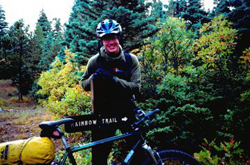
How to Mountain Bike Tour on Singletrack
Or, Becoming the Whipping Boy
June 21, 2005

|
| Nathan on the Rainbow Trail Copyright Nathan Ward |
We made it only half-way before it was officially dark. We stumbled and pushed another two miles until the air was black as coal. I waved my hand inches in front of my nose and couldn't see it at all. Trying to feel out the trail with our feet, we found ourselves constantly off-route, running into trees and stepping off little ledges. Convinced we would eventually reach our gear, we continued, risking becoming lost or walking off something big.
The final blow fell when we came upon a good size creek that we could plainly hear, but couldn't see at all. I inched forward, searching for the shoreline and found it only when I slid off the bank into the water. Since my feet were already wet, I waded across to look for the trail on the other side. It was so dark I had no idea which way to turn and kept running into tall rock walls. When I started to shiver from exposure there was really no going on.
The only smart thing we did that night was build a fire with a lighter and toilet paper. We spent the night half a mile from our gear while we shivered in the cold, kept awake by the loud grumbling of our empty bellies.
Earlier that morning we'd set out to attempt a three day long ride that covered 100 miles of singletrack in the Rocky Mountains of Colorado. Friends offered to drop our gear off at a trailhead the first night so we could spend a full day of riding unencumbered by extra weight. The joke was on us, since we bit off way more than we could chew and paid for it—our first attempt at touring singletrack didn't go well.
For most people, the simple act of riding on singletrack for a few hours fulfills their need for skinny tough trails. However, for the more intrepid, the possibilities of traveling on singletrack for days at a time—no longer tied to roads, shuttles and racing home before dark, opens up a world of opportunity, anywhere on the planet.
Singletrack touring is not for everyone and it resembles road touring about as much as difficult mountaineering compares to a walk in the park. Some people will say it's not fun at all and requires a Zen-like acceptance of depravity. If you're out for creature comforts, hot cups of coffee in your warm tent and lots of soft pillows, singletrack touring is not for you. If you want to know how much challenging terrain you can cover over time, want to challenge yourself and explore the world's more remote regions, read on.
The following is a list of suggestions that I've come up with over a few singletrack touring adventures. You can adapt them however you like.
"Singletrack touring is not for everyone and it resembles road touring about as much as difficult mountaineering compares to a walk in the park." |
1. Use the lightest gear possible. In this era of superlight gear created for adventure racing, it is very easy to purchase feathery gear that would have had to be custom-created in the past. Lightweight gear translates directly into easier riding and more fun. However, if it's a toss-up between spending more hours in the office to buy the lightweight gear, just use what you have. It's more important to be out on the trail than it is to spend all your time saving up for light gear.
2. Carry your gear in a hydration pack and on a rear rack. The two most important items, besides your body and bike, is a large hydration pack and a rear rack. The pack should be really comfortable, big enough to hold a bunch of junk and a three liter (100 oz.) water reservoir. I use the HyperLITE pack made by Wingnut ( HYPERLINK "http://www.wingnutgear.com" www.wingnutgear.com) because it's lightweight and rides low on my back, so it exerts less pressure on my upper body over the long haul.
Rear racks can be attached to both hardtails and full suspension bikes. The setup for a hardtail resembles a typical road touring arrangement and attaches with clamps or bolts into eyelets. The rack for a duallie clamps onto the seat tube, and though it's not as good as the hardtail rig, it works. Plus, a full-suspension ride treats your body so much nicer over tough trails.
3. Put your important gear in a dry bag. To keep your gear dry and somewhat protected, use a small dry bag that fits a sleeping bag (tightly compressed with a compression stuff sack), extra warm clothes and a few food items. A plastic bag can be used instead of a dry bag, though it's lighter, it could easily rip and spill your goods everywhere. Strap the dry bag to your rack with a couple of bungee cords.
The downside to using only a pack and dry bag is that it puts extra strain on your upper body and makes your bike top heavy. A top heavy bike behaves oddly at first and is more difficult to control, but after you get the hang of it, it's no big deal.
Overall, singletrack touring lends itself to simple food that doesn't require much preparation—gorp mix, beef jerky, pretzel pieces, hard candies, energy gel and sandwiches. Picky eaters will find the situation more challenging. If you're trying simply to pull the ride off successfully, a person can survive on almost anything for a few days. If you must have variety in your diet, take lessons from long-haul backpackers and bring light dehydrated meals. When I do these rides, it seems that I expend so much energy that I will consume anything within reach.
By Nathan Ward